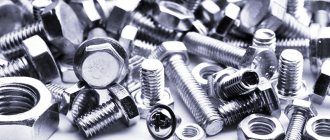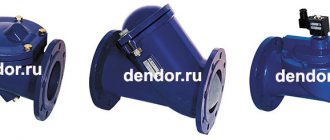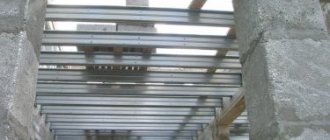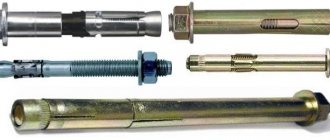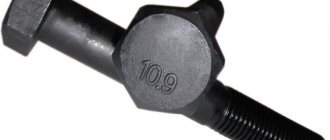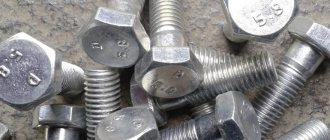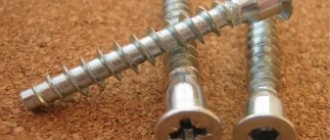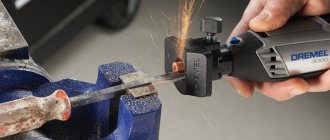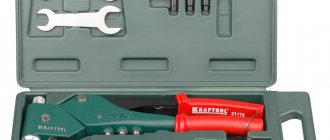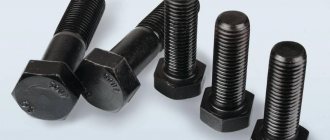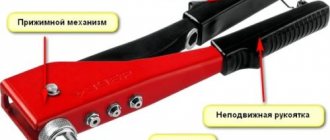Bolt components
Bolts are fasteners that consist of two parts: a threaded leg and a head that connects to the leg through a hole. Typically, these fasteners are made from high quality carbon steel. Depending on the manufacturing technology, bolts can be galvanized or non-galvanized.
The advantages of galvanized fasteners are that they are more resistant to corrosion and do not lose their metallic luster throughout their entire service life. Mostly such bolts are used in visible places where parts are connected, for example: during the assembly of furniture, various equipment, external cladding, as well as in interior furniture.
In addition, bolts can also be made of heat-resistant, stainless steel, but bolts are practically not made of copper or brass. Bolts are manufactured in accordance with GOST and DIN recommendations.
Standard production
In the CIS countries, the GOST standard is relevant. There are also DIN and ISO. These regulations specify standards that fastener manufacturers must adhere to.
When producing and selling a bolt, the products themselves must be marked with important symbols. GOST classifies hardware according to: shape, purpose, standard size, strength.
There are 11 strength classes. High-strength bolts are used directly for structures with heavy loads. They are produced by cold or hot heading method. Production is based on special powerful equipment.
According to the shape of the hat
Depending on the shape of the head and purpose, the following hardware is distinguished. The most commonly produced bolts have a hexagonal or round head, but they are also found with oval and square ones. In addition, the caps also differ in head size. So, according to DIN standards, there are such fasteners that have standard, reduced and enlarged profiles.
The shape of the head itself can also be of three types: flat, convex and hidden. The last form of head is the hidden one, which is used in furniture assembly. Sometimes during renovations, many people use bolts with a hidden head so that they do not spoil the aesthetic appearance of the room.
• on the first and second there is a hexagon-shaped cap;
• the third and fourth shows the shape of the head with turnkey flats;
• on the fifth, the bolt head has an internal hexagon;
• the sixth picture shows a hat with triangular slots;
• the seventh shows the hidden location of the bolt with internal hexagons.
Execution option
One of the main design features can be called a design option, which depends on the standard to which the hardware is manufactured. The generally accepted standards are GOST and DIN.
For example, in hex bolts, a distinctive feature may be the locking of the threaded connection. It is achieved through a hole through which a cotter pin or wire is threaded. If it is necessary to reduce the weight of the fastener without losing the strength of the connection, then a recess can be made in the head of the bolt.
By type of bolt leg
Generally, bolt legs are manufactured to a standard diameter across the entire shank. But there are also bolts on sale with a stepped leg, where the threaded part is already smooth. This shape of the bolt helps balance the load, which is why this type of fastener is used to connect very heavy parts. Thus, the following types of bolt are distinguished:
• with standard rods
• carriage bolt
• with a sealed foot for installation in the hole without gaps
• with a leg of a smaller diameter smooth part
What are bolts made of?
- Aluminum type of bolts: lightweight, resistant to oxidation, corrosion, heat resistant, easy to manufacture.
- Brass: durable, corrosion resistant, low magnetic permeability.
- Copper: withstands high loads, has excellent wear resistance, suitable for use near magnets.
- Plastic: budget options for light loads.
- Steel: Made from durable, carbonated iron. Uncoated steel is susceptible to corrosion.
- Made of hardened steel: stronger than others, but more fragile.
- Stainless Steel: Considered to be chemical and corrosion resistant with a premium finish.
- Made from superalloys: available with good mechanical strength, surface stability, corrosion resistance, and high temperature resistance.
- Titanium: strong, lightweight and corrosion resistant. When alloyed with other metals, strength and durability increase.
Technological production of bolts
There are two fundamentally different methods for manufacturing this type of fastener:
- Turning is the process of making bolts individually or in small batches from a steel bar on a screw-cutting lathe.
- Cold or hot stamping in a factory followed by thread rolling.
The bolt manufacturing process, regardless of the method, consists of the following steps:
- Preparing a metal rod (wire rod).
- Cutting workpieces to the required length.
- Making a chamfer at the end of the stud.
- Bolt head shaping.
- Thread cutting.
Quality control is carried out at all stages of production. When manufacturing hardware according to an individual drawing, the first manufactured part is checked with the most careful control. If deviations from the technical specifications are detected, the bolt manufacturing process should be reviewed and the cause of the discrepancy should be found.
Manufacturing on a screw-cutting lathe
The stages and methods of processing a workpiece depend on the type of source material (hexagonal or cylindrical rod, characteristics of the metal), as well as on the degree of accuracy of the workpiece. Hot-rolled blanks have less accuracy, which eliminates the possibility of precise centering of the future part on a turret lathe or on a CNC machine.
The technological process of manufacturing a bolt part on a lathe from a cold-drawn hexagonal rod is divided into several stages:
- A workpiece of the required length is cut from a steel bar using a hacksaw.
- The workpiece is fixed in a hexagonal collet so that the head of the part does not mix relative to the central axis of the future bolt.
- Trimming the end of the bar to size, centering it on a screw-cutting lathe.
- Grinding the workpiece to obtain the specified dimensions, chamfering using cutters.
- Cutting threads using a die or thread cutter.
- Grinding the bolt head, chamfering.
- Machining the head with a milling cutter.
If there are special requirements for the hexagon of the head of the part, the technical process of manufacturing the bolt on a lathe becomes more complicated. To prevent displacement of the head axis relative to the cylinder axis, the workpiece is subjected to additional processing.
Manufacturing of bolts by cold stamping
The first stage of the technical process is preparing the metal for the stamping process:
- The surface of the workpiece should be smooth and shiny. Surface cleaning under production conditions is performed mechanically or by calcination.
- Cleaning is carried out to remove scale and grease.
- Lubricating the surface of the workpiece (the surface of the metal is first coated with a lubricating layer; this is mandatory before drawing).
Scale from the surface of metal workpieces is usually removed by etching. To do this, the rod is immersed in a solution of sulfuric or hydrochloric acid of a certain concentration for a period of 5 minutes to half an hour. To eliminate pickling sludge, the workpieces are washed in hot water. If the etching was carried out using a sulfuric acid solution, the residues are washed off and neutralized by liming the rod.
The production of bolts from a metal rod occurs without heating the metal. The deformation of the workpiece during cold stamping is accompanied by cold hardening—an increase in the mechanical strength of the metal. The finished part is obtained by filling a standard die of a given configuration with the workpiece material. Next, the part is upset—the finished metal hardware is removed from the die.
Advantages of the cold stamping method in the production of bolts:
- High level of process productivity.
- Maximum surface cleanliness of parts and dimensional accuracy.
- Manufacturing of bolts with a core diameter of up to 52 mm.
When choosing a cold stamping method, you should take into account the ratio of the size of the head and the diameter of the rod of the part, as well as the ratio of the diameter of the head to its height and indicators of relative and true deformation. If the ratios for the listed quantities are higher than the critical values, the possibility of manufacturing the part by hot stamping should be considered.
Manufacturing of bolts by hot stamping
The essence of hot stamping is the precipitation of metal and its redistribution from the middle to the edges of the die. If stamping occurs in open dies, a metal burr (burr) is formed. Stamping in closed dies is called flashless. The manufacturing process of a bolt part using hot stamping begins with cleaning and cutting the workpieces. Then the blanks go through a full cycle of operations to transform them into durable and reliable fasteners:
- Heating up to 1000 degrees using an inductor.
- Forming the head of a part using an impact press.
- Chamfering on a milling machine.
- Thread cutting on an automatic machine.
To ensure high corrosion resistance of the fasteners, the bolts are galvanized. Coating stages:
- Washing parts in hot water.
- Chemical cleaning of the surface from metal oxides by etching in hydrochloric acid.
- Neutralize remaining acid by repeated rinsing with water.
- Immersion of parts in a zinc solution heated to a temperature of 450 degrees.
In chemical galvanization, a layer of zinc is deposited on the part in an electrolyte solution. The finished bolts are polished and mechanical defects are eliminated.
Hot stamping provides high strength characteristics of finished hardware. This primarily concerns stamping in closed dies. The increased strength is explained by the fact that the fibers, oriented according to the shape of the stamp contour, are not cut off along with the burr (flare-free stamping).
What is the difference between a screw and a bolt and a screw: comparison, photo
A screw differs from a screw and bolt in that it has a thinner thread and a pointed tip. Used without nut and washer. Most often, its surface is self-tapping, that is, when a certain force is applied, the self-tapping screw can be screwed into a wooden surface, without cutting a preliminary thread. Screws and bolts are not used for these purposes because they do not have a pointed tip and do not have a self-tapping characteristic.
Plumbing screw
Bolt
Screws
Strength class and materials of manufacture
The strength class of threaded connections means the tensile strength limit of the product. The strength class of these hardware depends on the mechanical properties of the product and is divided into 11 categories. By and large, this parameter is determined by the material used to make the bolts. They can be made from:
- Ordinary steels;
- Structural alloy and low alloy steels;
- Stainless steels and heat-resistant steels;
- Brass, copper, titanium and titanium alloys.
Steel grades and mechanical properties of bolts
| Strength class | Thread diameter, mm | Bolt steel grades according to GOST 1050 | Resistance value of a high-strength bolt, mPa (kgf/cm²) | Brinell hardness HB | ||
| min | Max | min | Max | |||
| 6,8 | 42 | 40x | 650(6600) | 850(8650) | 181 | 363 |
| 48 | 600(6150) | 800(8150) | ||||
| 8,8 | 36 | 800(8160) | 950(9700) | 242 | ||
| 9,8 | 30 | 900(9180) | 1150(11730) | 285 | ||
| 32 | 30ХЗМФ | 900(9180) | 1200(1240) | 300 | ||
| 48 | 30ХЗМФ | 900(9180) | 1200(1240) | 268 | ||
| 10,9 | 16-27 | 40x | 1078(11000) | 1274(13000) | 331 | 388 |
| 36 | 30ХЗМФ | 1000(10200) | 1200(12200) | 300 | 363 | |
| 36-48 | 30ХЗМФ | 1078(11000) | 1274(13000) | 331 | 388 | |
| 36-48 | 30X2NMFA | 1078(11000) | 1274(13000) | 331 | 388 | |
| 12,9 | 16-30 | 20Х2НМТРБ | 1274(13000) | 1519(15500) | 360 | 415 |
Areas of use
Bolts are used for fixation in detachable structures. If necessary, bolt-type fasteners can be disassembled. The connection with the bolt is static and rigid. The main area of use of bolts is the construction of load-bearing structures: car frames, machine beds, building frames.
Screws create a movable connection, which affects the area of their use. They are used in watch mechanisms and lathes. Self-tapping screws are used as fasteners to hold light weight objects (shelves, pictures, lamps).
Let's summarize. How does a bolt differ from a screw by definition and scope of use:
- In a bolted connection, the load is distributed perpendicular to the direction of the hole, in a screw connection - parallel to it.
- The threads in the screws are cut along the entire length of the stud; the bolt has a thickening between the head and the thread on the stud.
- A bolt is used with a nut, a screw - without it.
- Bolted fasteners are often large in size, unlike screw fasteners.
- Bolts are used in connections where it is necessary to withstand high loads.
- The head of the screw must have a slot for a screwdriver; the head of the bolt does not have such a slot.
Sources
- https://pkmetiz.ru/articles/bolt-i-vint-v-chem-raznica/
- https://SoproMats.ru/detali/bolt/
- https://StrojDvor.ru/strojmaterialy/bolt-m16/
- https://pkmetiz.ru/articles/izgotovlenie-boltov-tehnologii-marki-stali-process/
- https://www.vseinstrumenti.ru/krepezh/metricheskij/bolty/articles/klassy-prochnosti/
- https://NiceSpb.ru/zapchasti/iz-chego-sostoit-bolt.html
- https://met-all.org/metalloprokat/metizy/boltovoe-soedinenie-klassy-prochnosti-boltov-markirovka-gost.html
